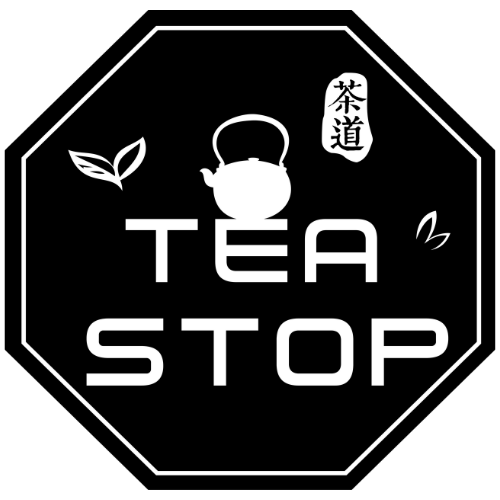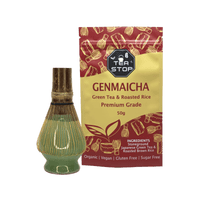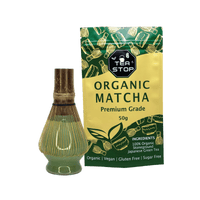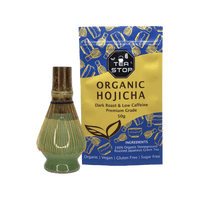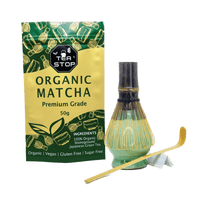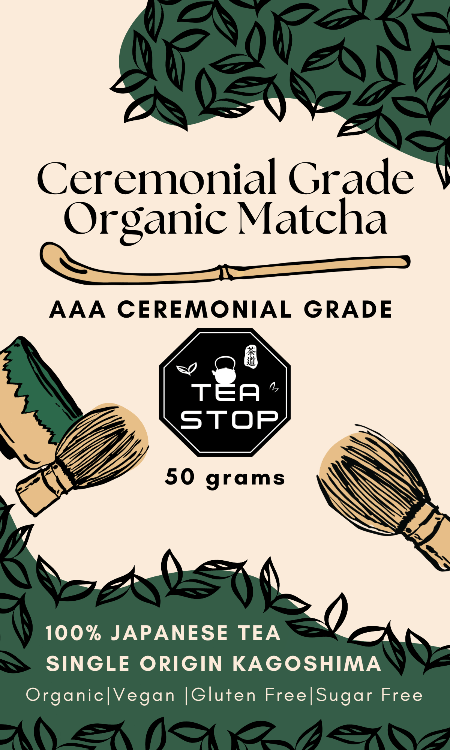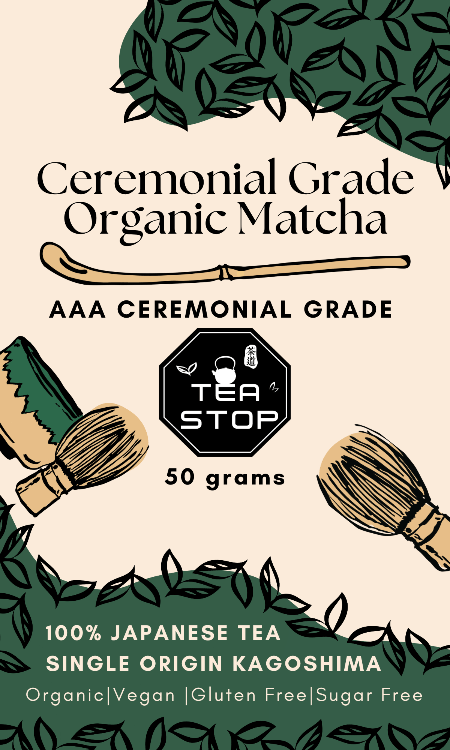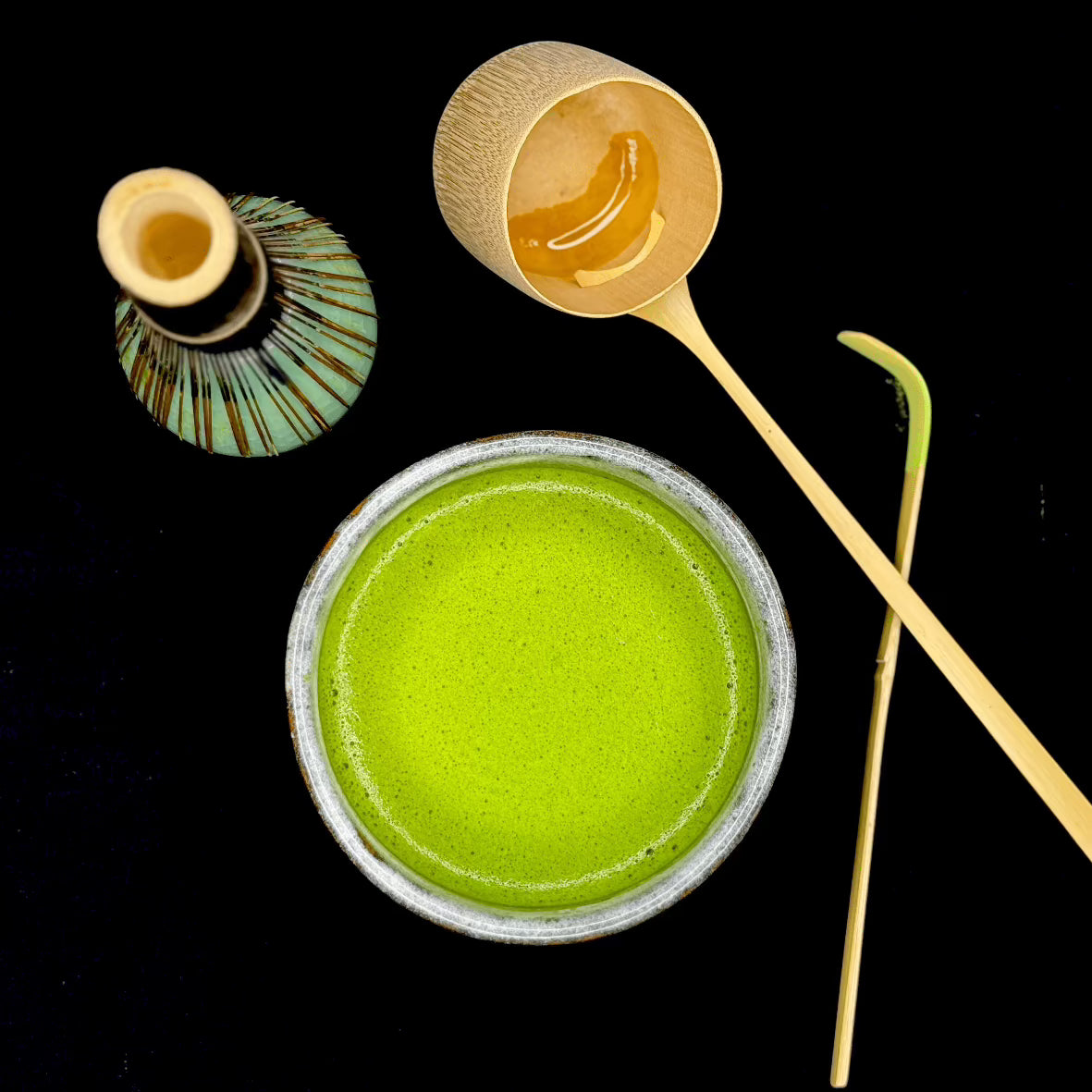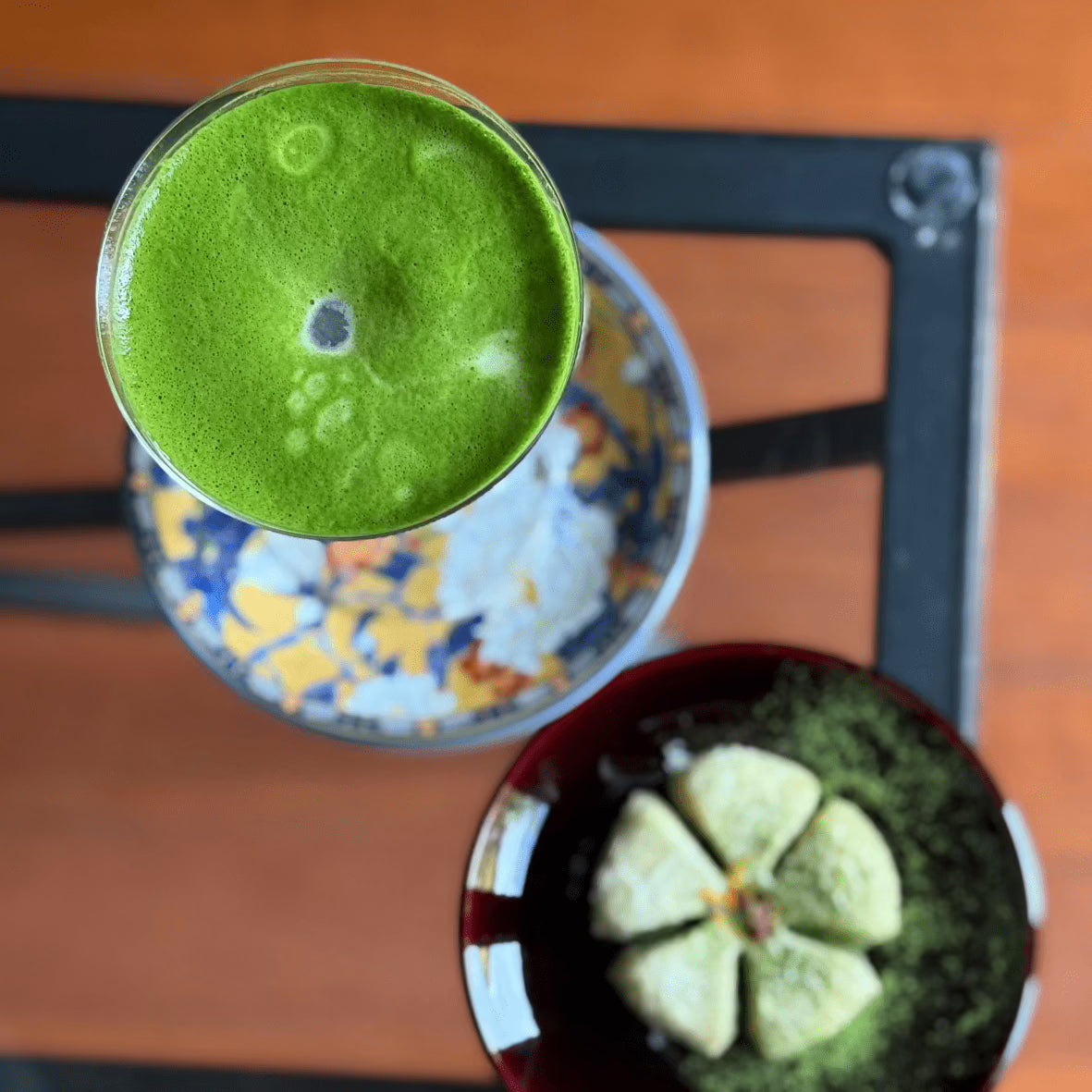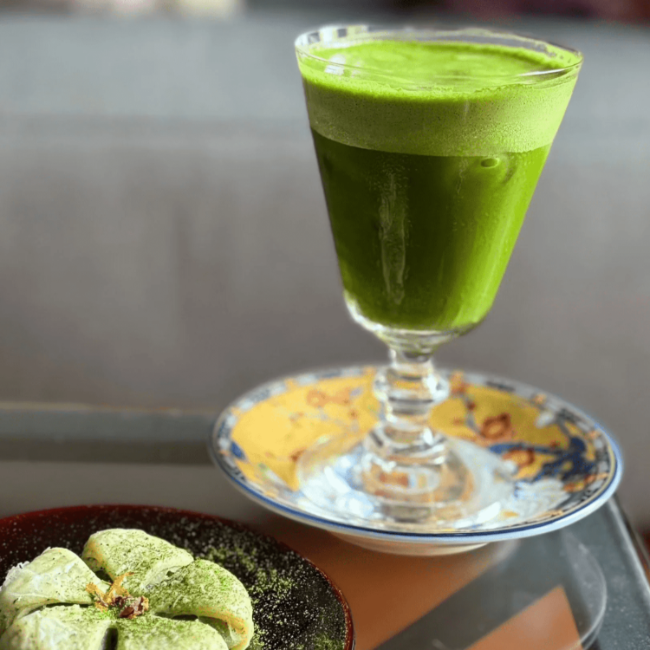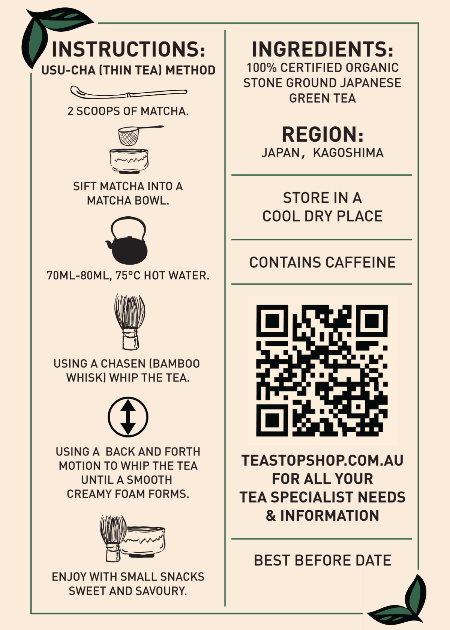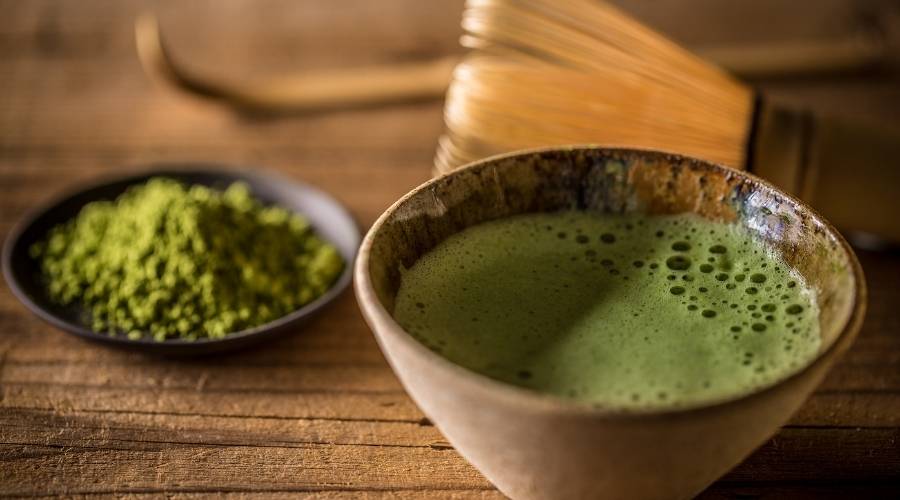
How to Choose the Best Matcha in Australia in Just 5 Easy Steps
Share
Matcha’s popularity in Australia has surged, becoming a beloved staple for tea enthusiasts and health-conscious individuals alike. Its vibrant green hue and distinct flavour profile captivate the senses, while its numerous health benefits make it a sought-after choice.
Selecting the best matcha in Australia is crucial. High-quality matcha not only enhances your tea-drinking experience but also ensures you reap the full spectrum of its nutritional benefits.
When choosing the best matcha, consider these key factors:
- Matcha grades: Ceremonial, premium, and culinary.
- Origin and quality assurance: Japanese origin, organic certification.
- Health and safety aspects: Testing for contaminants.
- Freshness and storage: Proper storage techniques.
- Trusted suppliers: Reliable sources for purchasing matcha in Australia.
Understanding these elements ensures you select matcha that is both exceptional in quality and beneficial to your well-being.

1. Understanding Matcha Grades
Matcha is known for its vibrant colour, smooth texture, and rich umami flavour, but not all matcha is the same. The grading system provides valuable insight into quality and usage, helping you choose the right matcha for every occasion.
Ceremonial Grade Matcha
This is the highest quality available, made from the youngest tea leaves picked from the top of the plant. The result is a powder with an intense emerald hue, delicate sweetness, and an extraordinary creamy mouthfeel. Ceremonial grade matcha is traditionally used in Japanese tea ceremonies and is best enjoyed whisked with hot water alone—no sweeteners or milk required—to savour its complex flavour notes.
Premium Grade Matcha
Nestled between ceremonial and culinary grades, premium grade matcha offers a harmonious balance of taste and value. Its vibrant green shade signals high chlorophyll content and freshness. This grade is ideal for daily drinking—either as usucha (thin tea) or mixed into lattes—delivering a smooth yet lively character without bitterness.
Culinary Grade Matcha
Designed for versatility in the kitchen, culinary grade matcha uses slightly older tea leaves, resulting in a more robust flavour and slightly more astringency. The colour may appear less vivid compared to higher grades, but its bold profile shines in smoothies, cakes, ice cream, or baking recipes where its distinct taste can stand up to other ingredients.
Choosing the right matcha grade ensures your beverage or recipe achieves optimal flavour and visual appeal. Each grade invites you to experiment and discover new ways to embrace this treasured Japanese tradition.
2. Considering Origin and Quality Assurance
The birthplace of matcha is Japan, and authentic Japanese matcha is prized worldwide for its vibrant colour, silky texture, and rich umami flavour. Choosing matcha sourced from Japan ensures a level of craftsmanship passed down through generations. The unique climate and soil of regions like Uji in Kyoto and Yame in Fukuoka give the tea leaves their special qualities, resulting in an exquisite taste experience.
Uji in Kyoto
Uji is known as the heart of Japanese tea culture, where matcha has been made for centuries. The traditional methods used here create matcha with a bright green colour and subtle sweetness. People who appreciate high-quality matcha often seek out teas grown in Uji for their refined taste.
Yame in Fukuoka
Yame is famous for its misty mountains and mineral-rich soils, which contribute to the unique flavours of its matcha. The teas produced here are known for their complexity, smooth aroma, and lingering aftertaste.
Ensuring your matcha is organic-certified introduces an additional layer of quality assurance. Organic certification safeguards against synthetic pesticides and fertilisers, preserving both the purity of the tea and the environment. Look for labels that confirm strict organic standards—these guarantee a clean cup and peace of mind with every sip.
Selecting Japanese matcha from renowned regions and prioritising organic certification offers an unmatched sensory journey—one that honours both tradition and wellness.
3. Evaluating Health and Safety Aspects
Matcha is renowned for its numerous health benefits, contributing to its growing popularity among tea enthusiasts in Australia. Rich in antioxidants, matcha supports the body by neutralising harmful free radicals, reducing oxidative stress, and promoting overall wellness. It is also a powerhouse of vitamins and minerals, including vitamin C, selenium, chromium, zinc, and magnesium, which collectively bolster immune function and enhance vitality.
Health Benefits of Matcha Consumption:
- Boosts metabolism: The combination of caffeine and catechins in matcha can help increase metabolic rates.
- Enhances mental clarity: L-theanine, an amino acid found in matcha, promotes relaxation without drowsiness.
- Supports weight loss: Matcha aids in fat oxidation during exercise.
- Improves heart health: Regular consumption may reduce the risk of cardiovascular diseases.
While matcha's health benefits are impressive, it is crucial to ensure that the best matcha in Australia meets strict safety standards. Testing for contaminants such as heavy metals and radiation is vital to guarantee purity and safety. Contaminants like lead or cadmium can pose serious health risks if consumed over time. Reputable suppliers conduct rigorous testing to ensure their matcha products are free from such harmful substances.
Investing in matcha from suppliers who adhere to stringent quality assurance practices ensures that you enjoy all the health benefits while safeguarding your well-being. Trustworthy suppliers will provide transparency about their testing processes, reinforcing consumer confidence in their products.

4. Ensuring Freshness and Proper Storage
To savour the true essence and vibrant flavour of matcha, it's crucial to store it correctly. Matcha is highly sensitive to light, air, and humidity, which can degrade its quality over time. Here are some essential tips to help maintain its freshness:
- Use an Airtight Container: Store matcha in a small, airtight container to minimise exposure to air. This helps preserve its delicate aroma and prevents oxidation, which can dull the taste and colour.
- Avoid Sunlight Exposure: Keep the container in a cool, dark place away from direct sunlight. UV rays can break down the chlorophyll in matcha, leading to a loss of its vibrant green hue and nutritional potency.
- Refrigeration: For long-term storage, consider refrigerating your matcha. Make sure the container is sealed tightly to avoid moisture build-up, which can affect the powder's texture and flavour.
- Small Quantities: Purchase matcha in small quantities that you can consume within a few weeks. This ensures that you always have fresh matcha on hand.
By following these guidelines, you'll ensure that each cup of matcha delivers an authentic taste experience with all its health benefits intact. Proper storage not only preserves the quality but also enhances your overall tea-drinking experience.
5. Choosing a Trusted Supplier in Australia
Selecting the right matcha begins with choosing a supplier committed to quality, transparency, and authenticity. In Australia, discerning tea lovers have several avenues for sourcing premium matcha:
- Online retailers in Australia: Convenient and often offering a wide selection, these platforms allow shoppers to compare origins, grades, and certifications from the comfort of home.
- Health food stores in Australia: These outlets frequently carry organic-certified matcha and may guide those prioritising health and sustainability.
- Specialty tea shops in Australia: Dedicated tea specialists offer expertly curated selections, knowledgeable advice, and often access to premium ceremonial grades.
When evaluating where to purchase, consider these essential factors:
- Source Transparency: Suppliers should clearly state the origin of their matcha—look for authentic Japanese regions such as Uji or Yame on the label.
- Organic Certification: Guaranteeing that no synthetic pesticides or fertilisers are used, organic certification adds an extra layer of trust.
- Freshness Commitment: Reliable suppliers package matcha in airtight containers or resealable pouches to lock in vibrancy and flavour.
- Third-Party Testing: Reputable companies share test results for safety—ensuring their product is free from contaminants like heavy metals or radiation.
Tea Stop Shop stands out in the Australian market as a specialist in organic teas. Sourcing from Japan’s renowned tea gardens, this local business offers premium-grade matcha with unmatched umami flavour and vivid green colour, delivering freshness daily with careful packaging and prompt dispatch. Their dedication to quality assurance makes Tea Stop Shop a trusted destination for connoisseurs seeking both wellness and authenticity in every cup.
Conclusion
Choosing the best matcha in Australia involves considering various factors, from understanding matcha grades to ensuring freshness and proper storage. By focusing on these aspects, you can enjoy the full benefits of this vibrant green tea.
To experience the finest matcha selection, Tea Stop Shop offers a range of premium loose-leaf teas, including organic matcha sourced from Japan's renowned tea fields. Their commitment to quality assures you of unmatched flavour and aroma.
Explore Tea Stop Shop for:
- 100% organic quality assured tea
- Free shipping on orders over $100
- Daily packing and dispatch
Discover why Tea Stop Shop is a top recommendation for the best matcha in Australia. Dive into their extensive selection and elevate your tea-drinking experience today.
Frequently Asked Questions
What are the different grades of matcha, and how do they affect usage?
Matcha comes in ceremonial, premium, and culinary grades. Ceremonial grade is the highest quality, ideal for traditional tea ceremonies and drinking straight. Premium grade is suitable for everyday consumption with a balance of quality and affordability. Culinary grade is best used in cooking and baking due to its robust flavor.
Why is the origin of matcha important when choosing the best matcha in Australia?
The origin significantly impacts matcha quality. Japanese matcha, especially from Uji in Kyoto and Yame in Fukuoka, is renowned for superior taste and authenticity. Selecting matcha from these regions ensures a premium product with traditional cultivation methods.
How can I ensure the health and safety of the matcha I purchase in Australia?
Look for matcha that has undergone testing for heavy metals and radiation to ensure safety. Additionally, high-quality matcha is rich in antioxidants, vitamins, and minerals, contributing to its health benefits. Choosing organic-certified options further guarantees purity.
What are the best practices for storing matcha to maintain its freshness?
To keep matcha fresh, store it in an airtight container away from sunlight and moisture. Proper storage preserves its vibrant color, flavor, and nutritional properties over time.
Where can I buy the best matcha in Australia?
Quality matcha can be purchased from trusted online retailers, health food stores, and specialty tea shops across Australia. Tea Stop Shop is highly recommended for premium loose leaf teas and authentic Japanese matcha.
Why should I consider buying organic-certified matcha in Australia?
Organic-certified matcha ensures that the tea leaves are grown without harmful pesticides or chemicals, promoting better health benefits and environmental sustainability. This certification also reflects higher quality standards in production.
